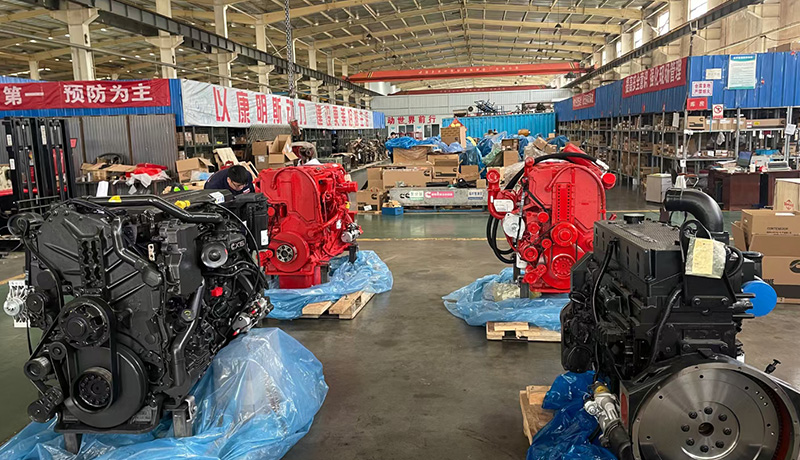Categories
- Blog (58)
- News & Events (34)

Repairing the diesel engine requires eight steps
1. “Three Leaks”
To prevent and solve the “three leaks” problem when repairing the diesel engine, the “five-character” principle can be adopted, that is, strict, clean, wiping, grinding, and tight. Strict: For the disassembly and installation of parts, strict requirements must be followed, operating procedures must be followed, and random knocking is strictly prohibited. For example, when tightening the bolts, they must be tightened in sequence and in several times, and do not twist in random order to prevent deformation of the parts. Clean: Before assembling the parts, be sure to clean them to prevent impurities from being mixed in. If the oil outlet valve and the valve seat contact annulus with very small debris, it will not only leak oil, but also directly affect the operation of the engine. Wipe: Apply asbestos oil to the oil leaks of asbestos pads, paper pads and various screw plugs. When applying the asbestos oil, it should be thin and even, not too thick, and do not apply the entire surface of the pad, only the part of the oil spill. Grinding: Grinding or milling the joint surface of parts, its function is to restore the surface finish and precision, so that after the oil pipe joint or gasket is ground, it can be kept sealed without oil leakage. Tightness: The tightness of the sealing device should be appropriate, not too tight or too loose, such as various contact surfaces of the diesel engine and sealing nuts, etc., must maintain a suitable tightness.
2. Cylinder pressure off
In order to ensure sufficient cylinder pressure, the matching clearance between the piston and the cylinder liner, the end and edge clearance of the piston ring must meet the requirements, the tightness of the valve and the valve seat, the tightness of the front end of the injector should be good, the cylinder gasket should be good, and the thickness should be good. meet the requirements.
3. The volume of the combustion chamber is closed
After the diesel engine is repaired, the volume of the combustion chamber often changes, the original compression ratio is changed, and the normal operation of the diesel engine is directly affected. Worn or bent, misplaced swirl chamber inserts, excessive valve sag, etc., attention should be paid to these conditions when repairing.
4, timing off
The timing switch includes the timing of oil supply and gas distribution. If the oil supply is not in time, the S195 and X195 diesel engines can be adjusted with the help of the gasket between the fuel injection pump and the gear chamber cover. Equivalent to the flywheel arc length of 6.3mm. If the air distribution is insufficient, check and correct the installation error of the timing gear first, and then adjust the valve clearance. For every 0.1mm change in the valve clearance, the crankshaft angle changes by 3 degrees, which is equivalent to the flywheel arc length of 11.1mm. When adjusting, pay attention to the piston When compressing to the top dead center, the gap between the intake and exhaust valves (cold state) cannot be less than 0.2mm to prevent the parts from being heated and expanding, the valve is not closed tightly, or the valve head hits the piston.
5. “Three filters” off
The air filter is in poor technical condition and will allow dust to enter the valve. Accelerating piston rings, cylinders, valves and valve seats are worn early, causing difficulty in starting and power reduction. The poor technical state of diesel and oil filters will cause impurities to enter between the relevant parts, causing early wear of the three precision couplings, accelerating the wear of the crankshaft and bearing bushes, and in severe cases, the diesel engine will be scrapped early.
6. Diesel atomization switch
The poor technical state of the plunger pair, the oil outlet valve pair and the injector needle valve pair will cause poor fuel injection atomization, making the diesel engine difficult to start, incomplete combustion, and increased carbon deposition, resulting in a decrease in engine power and an increase in fuel consumption. , Therefore, the fuel system, especially the precision parts, should be carefully checked.
7. Through hole and small hole close
(1) Through hole closure Now take the S195 diesel engine as an example, the 5 through holes of the bearing and bushing should be aligned during installation.
a. For the main bearing, oil holes are drilled on each pair of main bearing oil grooves, which are respectively connected with the oil on the cylinder block and main journal. During installation, as long as the flange notch of the main bearing is aligned with the locating pin, it can prevent the main bearing. Rotate to ensure that the oil holes are aligned, so that the lubricating oil path is unobstructed and avoids burning out.
b, rocker bushing. When the bushing is pressed into the rocker arm, if the holes are not aligned, the rocker arm shaft and bushing will be burnt due to lack of lubrication, dry friction, and the valve clearance will become larger, resulting in a serious knocking sound.
c, connecting rod bushing. The small end of the connecting rod is drilled with an oil collecting hole, which is connected with the oil hole of the connecting rod bushing. When the copper sleeve is inserted into the small end of the connecting rod, if the two oil holes are not aligned, the copper sleeve and the piston pin will be knocked “dangdang”. Hit, or even bite to death.
d. Start the shaft bushing. When installing the starter shaft bushing, the oil holes of the two bushings should be in communication with the corresponding oil collecting grooves on the body and the gear cover, otherwise the starter shaft and the bushing will wear faster and cause oil supply. The angle and valve phasing changes, resulting in a reduction in the power of the diesel engine.
(2) The small hole gate mainly has the following 4 small holes
a. Fuel tank cap vent hole. After the hole is blocked, the fuel tank is no longer connected to the atmosphere, and the upper part of the fuel tank will have negative pressure due to the drop of the oil level, which will cause the fuel supply to be interrupted. This hole cannot be blocked.
b. Crankcase ventilation holes. After the ventilation holes are blocked, the exhaust gas in the crankcase will accumulate more and more, and the air pressure in the crankcase will increase, which will cause oil leakage. The parts are worn out, so be sure to clear this hole during maintenance.
c. Drain hole of oil pump. The blockage of the oil drain hole on the oil transfer pump will cause a small amount of diesel leakage between the push rod and the conduit to enter the fuel injection pump, dilute the lubricating oil in the casing, and accelerate the wear of parts. Therefore, this hole cannot be blocked.
d. Water pump drain hole. If the hole is blocked, the leaked water will not be discharged from the pump body and enter the bearing seat, which will accelerate the damage of the bearing. Therefore, this hole must be cleared during maintenance.
8. Break-in
(1) Cold run-in. Remove the injector, drive the diesel engine with external force, check the oil pressure and the temperature of each part, and pay attention to the sound of each part. After cold running-in, when the temperature is high, release the oil and clean the oil filter and oil passage.
(2) Hot run-in. No-load thermal run-in, pay attention to the working conditions of the diesel engine and the noise of various parts; thermal run-in according to the specified load and time, often pay attention to the sound of each part and the blow-by gas, smoke exhaust, fuel return of the fuel injector, etc. of the oil port, and problems should be eliminated in time. .
